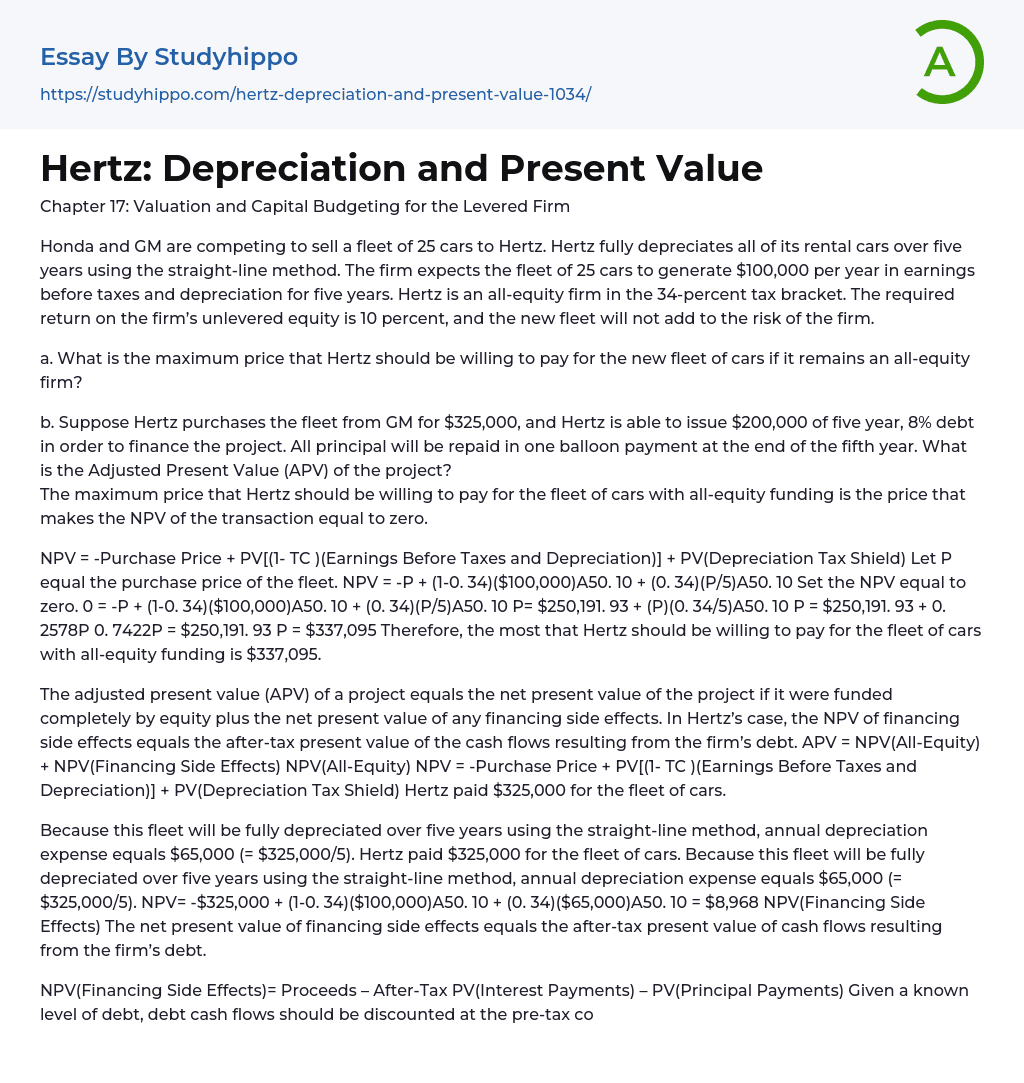Chapter 17: Valuation and Capital Budgeting for the Levered Firm
Honda and GM are competing to sell a fleet of 25 cars to Hertz. Hertz fully depreciates all of its rental cars over five years using the straight-line method. The firm expects the fleet of 25 cars to generate $100,000 per year in earnings before taxes and depreciation for five years. Hertz is an all-equity firm in the 34-percent tax bracket. The required return on the firm’s unlevered equity is 10 percent, and the new fleet will not add to the risk of the firm.
- What is the maximum price that Hertz should be willing to pay for the new fleet of cars if it remains an all-equity firm?
- Suppose Hertz purchases the fleet from GM for $325,000, and Hertz is able to issue $200,0
...00 of five year, 8% debt in order to finance the project. All principal will be repaid in one balloon payment at the end of the fifth year. What is the Adjusted Present Value (APV) of the project?
The maximum price that Hertz should be willing to pay for the fleet of cars with all-equity funding is the price that makes the NPV of the transaction equal to zero.NPV = -Purchase Price + PV[(1- TC )(Earnings Before Taxes and Depreciation)] + PV(Depreciation Tax Shield) Let P equal the purchase price of the fleet. NPV = -P + (1-0. 34)($100,000)A50. 10 + (0. 34)(P/5)A50. 10 Set the NPV equal to zero. 0 = -P + (1-0. 34)($100,000)A50. 10 + (0. 34)(P/5)A50. 10 P= $250,191. 93 + (P)(0. 34/5)A50. 10 P = $250,191. 93 + 0. 2578P 0. 7422P = $250,191. 93 P = $337,095
View entire sampleJoin StudyHippo to see entire essay
Therefore, the most that Hertz should be willing to pay for the fleet of cars with all-equity funding is $337,095.
The adjusted present value (APV) of a project equals the net present value of the project if it were funded completely by equity plus the net present value of any financing side effects. In Hertz’s case, the NPV of financing side effects equals the after-tax present value of the cash flows resulting from the firm’s debt. APV = NPV(All-Equity) + NPV(Financing Side Effects) NPV(All-Equity) NPV = -Purchase Price + PV[(1- TC )(Earnings Before Taxes and Depreciation)] + PV(Depreciation Tax Shield) Hertz paid $325,000 for the fleet of cars.
Because this fleet will be fully depreciated over five years using the straight-line method, annual depreciation expense equals $65,000 (= $325,000/5). Hertz paid $325,000 for the fleet of cars. Because this fleet will be fully depreciated over five years using the straight-line method, annual depreciation expense equals $65,000 (= $325,000/5). NPV= -$325,000 + (1-0. 34)($100,000)A50. 10 + (0. 34)($65,000)A50. 10 = $8,968 NPV(Financing Side Effects) The net present value of financing side effects equals the after-tax present value of cash flows resulting from the firm’s debt.
NPV(Financing Side Effects)= Proceeds – After-Tax PV(Interest Payments) – PV(Principal Payments) Given a known level of debt, debt cash flows should be discounted at the pre-tax cost of debt (rB), 8%. NPV(Financing Side Effects)= $200,000 – (1 – 0. 34)(0. 08)($200,000)A50. 08 – [$200,000/(1. 08)5] = $21,720 APV APV = NPV(All-Equity) + NPV(Financing Side Effects) = $8,968 + $21,720 = $30,688 Therefore, if Hertz uses $200,000 of five-year, 8% debt to fund the $325,000 purchase, the Adjusted Present Value (APV) of the project is
$30,688. 17. 2The adjusted present value of a project equals the net present value of the project under all-equity
- Income Statement essays
- Net Present Value essays
- Attitude essays
- Goals essays
- Personal Goals essays
- Personal Life essays
- Personality essays
- Principles essays
- Reputation essays
- Self Awareness essays
- Self Esteem essays
- Self Reflection essays
- Self Reliance essays
- Strengths essays
- Value essays
- Values essays
- Weakness essays
- Who Am I essays




